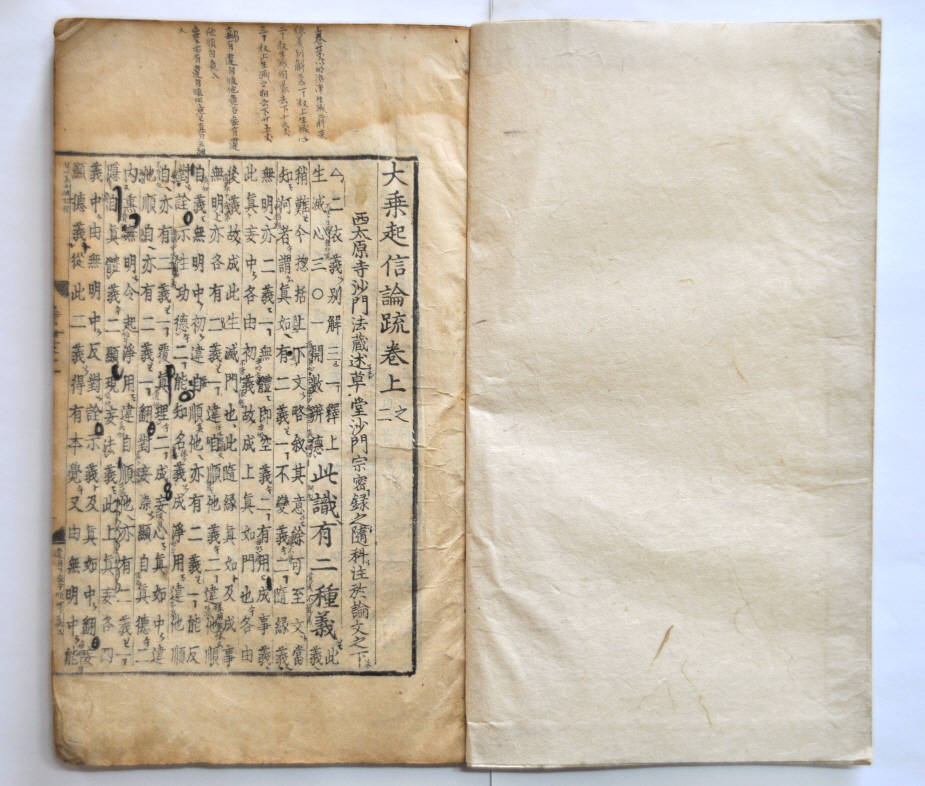- 홈
- Unique Historic Tourism
- Cultural Properties
- Daeseunggisinnonso
Daeseunggisinnonso

Daeseunggisinnonso
- Location
Namgu, Daegu
- Type
National Treasure No. 1713
Detailed Information
| Category | Documentary heritage / Records / Printed books / Metal printed books |
|---|---|
| Quantity/size | A book series consisting of three volumes |
| Date of designation (registration) | April 29, 2011 |
| Historical period | Joseon Era |
| Holder (holding organization) | Kim** |
| Manager (managing organization) | Kim** |
| Description |
Daeseunggisinnonso is an annotated edition on Daeseunggisinnon (Mahāyāna Sraddhotpada Sastra or Treatise on Awakening the Faith of Mahāyāna) written by the Indian Monk Maming (Aśvaghoṣa) and translated by Monk Fazang of the Chinese Tang Dynasty. Daeseunggisinnonso consists of three volumes of Buddhist Scriptures printed using movable metal printed type (1st Cast Gabin type) in 1457 during the Joseon Era. Daeseunggisinnon is known to be the work of Maming, but some claim it is an apocryphal text compiled in China. The Daeseunggisinnonso details the author’s understanding of the Gisinnon, a main Buddhist teaching, which is further categorized into the Seobun, Jeongjongbun, and Yutongbun. The Jeonjongbun, which is the main text, is comprised of the Inyonbun, Ipeuibun, Haeseokbun, Suhaengseonshimbun, and Gwonsuiikbun. In essence, the Gisinron summarizes the central theories and practices of Mahayana Buddhism, and although it is short, it is regarded as an extremely valuable piece of literature in Buddhist Studies. Gisinronsamso (Three Commentaries on the Awakening of Faith in the Mahāyāna) is comprised of Fazang’s So (annotated text) together with that of Wonhyo and Haewon. Fazang’s So is known to have been written under the influence of Wonhyo’s Gisinnonso (Commentary on the Awakening). It differs from Fazang’s Uigi (Annotated Commentary on the Awakening of Faith in the Mahāyāna) in terms of its content and layout. The Daeseunggisinnonso is recorded as having been compiled by Fazang in the form of “three volumes of So” according to Gyojangchongrok (a book listing Buddhist places) by Daegakguksa Uicheon, a monk of the Goryeo Dynasty. Gisinronsamso is the only type of this book still in existence today. Under the title of each volume is printed, “Written by Fazang,” and underneath is the name “Zhongmi,” the annotator. Gwonsangjiyi, Gwonhajiyil, and Gwonhajiyi are the three volumes of the series; Gwongsangjiyil, unfortunately, has been lost over time. The end of the series includes the Eoje-Balmun (Royal Postscript) written by King Sejo in 1457 in memory of his son. This book series—which contains Fazang’s So annotated by Zhongmi—is a type of Buddhist Scriptures that was published in the 1st Choju Gabin type in the yearly journal of King Sejong of the Joseon Dynasty. It was published numerous times and widely distributed in Japan; however, this particular book series is known to be the only original extant copy in Korea. Although a part of the book is regretfully missing, it is a valuable resource for Buddhist Studies and the study of ancient metal printed books of the early Joseon Period. |

- 자료 담당자 :
- 문화관광과 차명아 664-3252
- 최근자료수정일 :
- 2019.11.29
